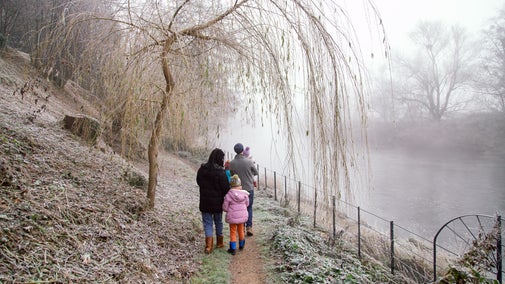Woodcock Wood walk at Hughenden
Oxfordshire, Buckinghamshire & Berkshire
This leisurely walk takes you on a short loop around typical Chiltern farmland and woodland on the Hughenden estate. You'll walk through the peaceful Woodcock Wood to a viewpoint that takes in the Chilterns countryside and Hughenden Valley village. The route back goes along ‘Coffin Path’, named after the ancient road that was used for taking the parishioners of Naphill on their final journey to the church in Hughenden.
Near to
HughendenStart point
Start at the visitor welcome kiosk. Grid Ref SU860955Trail information
*Mostly level walk across variety of gravel and grass surfaces. For further details, see section marked Terrain.
**Mainly level walk with one steep section. For further details, see section marked Access.
***Dogs should be kept on a lead near livestock. For further details, see section marked Facilities.
Look out for blue waymarker arrows
This walk is waymarked with blue marker arrows at all main changes of direction.
More near here
Boundary walk at Hughenden
Explore beautiful woodland, open parkland, farmland and a rare chalk stream on this energetic 4-mile circular walk that runs close to the estate boundary.

Hughenden's Monument walk
Discover a short 2-mile return walk with moderate hill climbs that takes in the monument at Hughenden. Take in far-reaching views from the monument which is known to be is one of the best look-out points the area.

Get in touch
Our partners

We’ve partnered with Cotswold Outdoor to help everyone make the most of their time outdoors in the places we care for.
You might also be interested in
Walking
Explore some of the finest landscapes in our care on coastal paths, accessible trails, woodland walks and everything in between. Find the best places to walk near you.

Staying safe at National Trust places
The special places in National Trust care sometimes come with a few risks for visitors, be it coastline or countryside. Find out how to keep safe throughout your visits.

Cotswold Outdoor: our exclusive walking partner
Learn about the National Trust’s ongoing partnership with Cotswold Outdoor. Find out how they help us care for precious places and the exclusive discount available for National Trust supporters.

Walking in Oxfordshire, Buckinghamshire and Berkshire
From gentle strolls for little legs to longer hikes through the rolling Chiltern hills, these are some of the best walks in Oxfordshire, Buckinghamshire and Berkshire.


